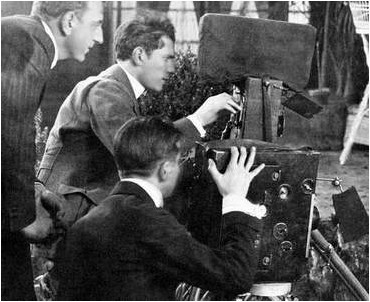
This documentary combines photographs from private collections and restored footage from such films as Thomas A. Edison’s “Rescued from an Eagle’s Nest” and D.W. Griffith’s “The New York Hat,” featuring Mary Pickford and Lionel Barrymore and filmed at the studios in Fort Lee.
D. W. Griffith made many one-reel Biograph dramas there (Mack Sennett appeared in his first film). Pearl White endured the “Perils of Pauline,” and Mary Pickford and Theda Bara starred in early features.
The American film industry got its start with the construction of Thomas Edison’s “Black Maria”, the first motion picture studio, in West Orange, New Jersey. New Jersey offered land for studios for much less than nearby New York City. By about 1916, a dozen major movie studios were operating across the Hudson River from Manhattan.
The movies came to Fort Lee when pioneer companies started to look for new filming locations. In 1907, it was found that the Palisades near Fort Lee and Coytesville could be used for “Wild West” scenes and other outdoor scenes. Rambo’s Hotel on First Street was used as a place to dress as well as for the exterior of a Western saloon.
In 1907, Thomas Alva Edison used the cliffs of the Palisades for the exterior of “Rescued from an Eagle’s Nest.” It was in this picture that D.W. Griffith, later to become more famous as a director, first appeared in a starring role as an actor.
In 1914, with the expansion of the giant French film companies into the United States market, Maurice Tourneur moved to the United States to direct silent films for Éclair’s American branch studio in Fort Lee.
His once-lost 1917 feature, A Girl’s Folly, is included on the DVD of Before Hollywood, There Was Fort Lee, N.J in a half-hour abridgement with views of the glass stages, rotating sets, tank for water effects, projection room, and crews at work, along with his hour-long 1914 feature, The Wishing Ring.
Watching these early films, you can see the development of film language with the early use of editing, intercutting and the variety of shots (fewer long shots and more close medium shots) which was rare in early films.
Fort Lee also prospered with the businesses that came to the city to service the film studios. Fort Lee’s reign as the film capital lasted about 20 years. Nestor Studios of Bayonne, New Jersey built the first studio in Hollywood in 1911. Later, Nestor merged with Universal Studios and co-owner William Horsley’s other company, Hollywood Film Laboratory, is now the oldest existing company in Hollywood (now known as Hollywood Digital Laboratory).
California’s climate was more cost-effective and by the 1930s pretty much all filmmaking had moved to the West Coast.
Another motivation to be on the opposite coast was because at the time Thomas Edison owned almost all the patents relevant to motion picture production. Movie producers on the East Coast who violated Edison’s Motion Picture Patents Company were often sued. Movie makers on the West Coast were able to work independently of Edison’s control.
MORE

